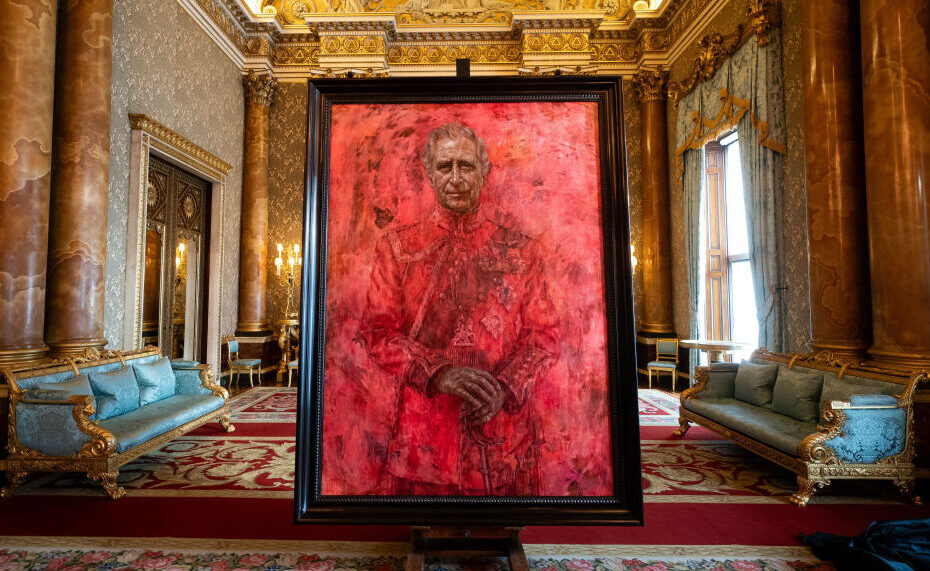Why Modern Art Isn’t Right
Even a king can’t get a good portrait in an age of equality.
∙

The strange new official portrait of Charles III is an occasion for conservatives to ask once more, “What’s wrong with modern art?” And is there any alternative to it, if this painting is the best that even a king can get?
Portraiture and monarchy have little place in today’s world—neither is extinct, though each has been largely deprived of function. The king reigns but does not rule. Portraits have prestige but are no longer necessary for memorializing or promoting anyone’s appearance. Democracy and photography have taken over the work of the old forms.
So the king’s portrait evokes dilution. Charles floats as a head on a hardly visible body, an indistinct figure subsumed by red haze. The color is simple and striking, as it must be to catch the desensitized eye. A royal portrait has to compete with every other meme and image today. Only the bizarre has a chance of standing out.
Charles is a neo-traditionalist in certain respects. He dislikes modern architecture and urban planning, for one thing, and has championed the creation of Poundbury, a town being built in Dorset along New Urbanist lines. But his portrait is placeless and modern, recalling a controversial 1997 depiction of his mother by Justin Mortimer.
That painting, commissioned by the Royal Society of the Arts, had Elizabeth II’s head completely detached from her body, against a blank yellow background. The artist may have been channeling his own detachment from his subject: “I don’t have anything in common with her apart from being English,” he told the Wall Street Journal in 2011.
Alienation and crude technique, often coupled with shock or outright obscenity, are familiar characteristics of modern art. What once may have been jarring enough to be liberating has long become formulaic. But royal portraits are a stodgy enough medium that a work like Jonathan Yeo’s crimsoned King Charles can still provoke a few days’ headlines.
The classics of modernism can still stir a reaction as well. A friend recently wrote on Facebook about seeing a Jackson Pollock painting—perhaps better described as just Jackson Pollock paint—at a museum in Philadelphia. He asked the docent why Pollock’s splatters of color weren’t something that any visitor could drip on a canvas himself. He was told Pollock did it first, which might come as a surprise to parents of small children.
Cultural scholars of a free-market bent have ventured an explanation for the primitive, ugly, offensive, and kitschy character of so much modern art. In an age when any consumer can own the symphonies of Beethoven or take a cheap flight to see the Mona Lisa firsthand, tastemakers whose own tastes were shaped by anti-capitalist intellectuals came to see the enjoyment of beauty as dreadfully vulgar. Something had to distinguish persons of enlightened sensibility from the vile bourgeoisie. But what could the great and good buy that the public couldn’t copy?
The answer wasn’t something that the masses couldn’t afford but something that they wouldn’t want—un-beautiful and unpopular things, the less appealing or more transgressive the better. On this account, elite anxiety is the root of modernism at its worst. Off-putting works are to be cherished precisely for their power to repel the right sort of person.
Whether or not the elite collectors of such works enjoy them in themselves, finding the pickled sharks of Damien Hirst pleasant to stare at, they can enjoy them for what they signify relative to cultural opponents. A man loves money not because he delights in the design of a hundred-dollar bill but because he can use the currency to get what he wants from other people, and that power in the abstract makes money desirable even apart from its use. Ridiculous or repulsive art is also something a collector can learn to love not for its immediate aesthetic qualities—which might be bitter even to progressive tastes—but for the social or anti-social magnetism it exhibits.
Alexis de Tocqueville might offer a different explanation, however. Our elites are out of touch with popular feelings, but they are not immune to the pressures of egalitarianism. How can one justify being rich or otherwise of high status in a society that prizes equality?
The wealthy don’t want to lose their wealth, but few would want to defend their unequal place by adopting a consciously aristocratic or selfish philosophy. That would be not only socially unacceptable but psychologically dissonant. Most people, rich or poor, want to be judged good by the standards of the society in which they live, not least in the court of their own conscience.
But to be an enemy of inequality can suffice as an alternative to actually being equal. This accounts for the perversity of much of the American political left, which is often wealthy or well-educated yet insists on pretending to champion the lowly and marginal. Hating traditional, even mythical, sources of inequality substitutes for loving one’s neighbor. In the world of art on either side of the Atlantic, egalitarian virtue takes the form of rejecting the past and its values. Monarchy and traditional portraiture were features of a West less egalitarian than today, and by opposing and parodying such things the artist places himself on the right side of history.
All things associated with the inegalitarian past must be shunned or inverted. That includes the orthodox religion and sexual morals of the past, but it also includes the forms and aesthetics of traditional art. That was the art of princes and lords, factory owners and fat-cat businessmen, all of whom were proud of their more-than-equal status, whether they inherited it or won it. Excellence in established techniques is itself a form of inequality, and that too should be depreciated. Thus the moral triumph of a Jackson Pollock dripwork, the very reason it deserves to be in a museum or sell for millions, is that it’s a perfectly egalitarian work which anyone can do, yet done by someone of unequal reputation who nonetheless has placed himself on the side of equality by rejecting the inegalitarianism of form and beauty.
This Tocquevillian perspective accounts for why the thrill of transgression never wears off for the transgressors, no matter how old and predictable “modern” art becomes. Although morally and formally transgressive work is usually promoted as having some power to jolt the soul—and perhaps early on it did—the underlying logic of such art today is about conformity, not novelty: fitting in with the elite opponents of the old elitism.
This also means that the prospects for conservative or right-wing art are meager. Conservatives characteristically cherish the forms and morality of the past. This places them, often unintentionally, on the side of inequality. Yet conservatives are not rebellious by nature, and they too are sons and daughters of an egalitarian society. The result is a dilemma: to imitate the forms of the past without the spirit that made its classics possible means to be condemned to producing only second-rate work, or worse. But to try to adopt the spirit of an earlier time means to become freakish in the here and now, and is such a psychologically shattering thing to do that hardly any sane person, let alone a conservative, would attempt it. Those who do usually wind up becoming harmless curiosities; a few turn out like Yukio Mishima.
Yet the Tocquevillian analysis may go too far. When photography replaced painting and other visual arts as the medium for conveniently capturing images of faces, places, and objects, the old arts had every reason to adopt new aesthetics that no camera could replicate. Presentation remained as a defining quality of art, even if its former function of representation had been usurped. Impressionism, surrealism, and other modern styles showed the world in ways that photographs typically could not. And the subjects of presentation eventually came to include the elements of which painted images are composed—shapes, colors, even splatters of paint. Other artists presented as subjects for attention objects that had never been considered in such a light. This could serve to detract from the traditional priorities of art, but in individual cases that need not be so. Modern art does reflect modern conditions, sometimes in ways that produce not alienation but contemplative detachment of a sort that Schopenhauer might endorse. The problem of modern art is not that it’s not traditional, but that it easily becomes the opposite of what it’s advertised as being: an orthodoxy and straitjacket rather than a release from thoughtless imitation.
Tocqueville advised those who were wise enough to recognize the virtues of aristocracy to find ways to supply those virtues, or similar ones, through democracy. The challenge of cultivating new art forms that can express beauty and excellence as well as the old ones did is a test of Tocqueville’s prescription. The late cultural critic Paul Cantor was optimistic that the worst and ugliest modernist literature of the twentieth century would soon be forgotten, and the best commercial literature of the era, such as Tolkien, would find a place in the canon a century from now. The Lord of the Rings is, of course, a monumentally popular bestseller about a world more medieval than modern, yet not without a certain noble egalitarianism. There are ways out of the impasse that the end of the old order has led to.
What that might look like on canvas is hard to say, but King Charles the Red isn’t it.



No comments:
Post a Comment